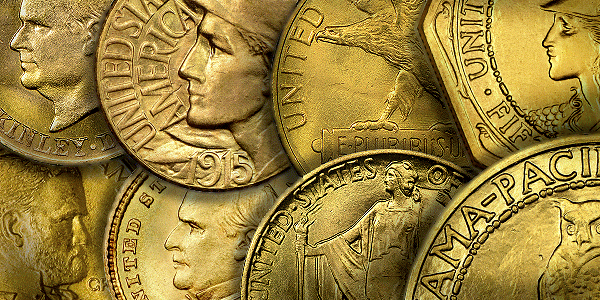
By Jeff Garrett for Numismatic Guaranty Corporation (NGC) ……
This is a great time to collect one of the most interesting and attractive United States coins series
My last article focused on classic commemorative silver coins struck from 1892 to 1954. As enumerated, there are many compelling reasons to collect this long-ignored series. Nearly all of the same reasons apply to its companion series, classic US gold commemorative coins struck from 1903 to 1926. Without the expensive 1915-S Panama-Pacific $50 gold coins, this short series is easy to assemble and can be found in very high grade. Commemorative gold coins are normally quite popular with the large rare coin marketing companies. The series is now being ignored and prices are near multi-decade lows.
US gold commemorative coins are a mirror of American history reflecting social and economic triumphs and struggles. The minting of commemorative coins dates back as far as ancient Greece, which issued coins to commemorate military victories, sacred animals, cities and heroes.
The creation of a United States commemorative coin requires congressional legislation because usually they are not minted for public circulation but rather for collecting. All US commemorative coins were minted in recognition of special historical events or to raise money for an event being commemorated.
Accomplished artists were commissioned to develop designs for many of the new issues. Several were students of Augustus Saint-Gaudens, having worked with him at his artist colony in Cornish, New Hampshire. Nine types of US commemorative gold coins have been issued over the last two centuries. The first souvenir US gold commemorative coin was minted in 1903 to commemorate the centennial celebration of the Louisiana Purchase in 1803 and was released at a national exposition. Because of the small number of coins, each will be examined in detail.
CIRCULATION STRIKES
1903 Louisiana Purchase Exposition Gold Dollar–Jefferson
- Net Mintage: 17,500
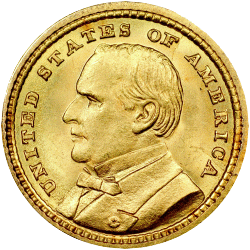 The first United States commemorative coins struck in gold were the gold dollars for the held in St. Louis in 1904. There were two distinct coins, both designed by Charles Barber. The obverse of one of these features Thomas Jefferson, who was president of the United States when the Louisiana Purchase took place in 1803. Although 125,000 pieces were authorized, only 17,500 examples were released to the public. The remaining pieces were melted.
The first United States commemorative coins struck in gold were the gold dollars for the held in St. Louis in 1904. There were two distinct coins, both designed by Charles Barber. The obverse of one of these features Thomas Jefferson, who was president of the United States when the Louisiana Purchase took place in 1803. Although 125,000 pieces were authorized, only 17,500 examples were released to the public. The remaining pieces were melted.
The original issue price was $3 each.
The Jefferson is usually seen well-struck, although weakness at the borders is not unusual. Prooflike examples are seen with regularity, some with surfaces that may be easily confused with a true proof. Original boxes of issue are sometimes seen, and many were also mounted in stickpins for jewelry. Most of the survivors seen are Choice Uncirculated.
1903 Louisiana Purchase Exposition Gold Dollar—McKinley
- Net Mintage: 17,500
William McKinley was president of the United States in 1901, when the Louisiana Purchase Exposition in St. Louis was authorized. Later that year, he was assassinated in Buffalo, New York. Originally, only the Jefferson version of this coin was to be issued, but another gold dollar featuring McKinley was issued after McKinley’s assassination. Charles Barber also designed this coin, which had a net mintage (17,500 pieces) identical to the Jefferson gold dollar version.
As with the Jefferson issue, the original price for the McKinley gold dollar was $3.
Prooflike examples are not uncommon and some can be very difficult to distinguish from true proofs. The coins were originally sold in a simple white box and these are sometimes available. The survivorship of the McKinley issue is slightly less than the Jefferson issue.
1904 Lewis and Clark Exposition Gold Dollar
- Net Mintage: 10,025
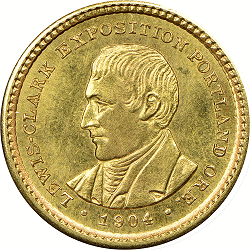 In early 1904, Congress optimistically authorized 250,000 gold dollars struck to commemorate the northwest discovery by explorers Meriwether Lewis and William Clark from 1803-1806. Charles Barber designed these gold dollars struck at the Philadelphia Mint in 1904 and 1905. These were released during the Lewis and Clark Exposition (centennial) in Portland, Oregon. Although 25,000 1904 dated examples were struck; only 10,025 pieces were reported sold. Before the exposition opened a coin dealer in Portland, Oregon advertised the 1904 issue at $2.50 each. He falsely claimed that the supply was nearly exhausted.
In early 1904, Congress optimistically authorized 250,000 gold dollars struck to commemorate the northwest discovery by explorers Meriwether Lewis and William Clark from 1803-1806. Charles Barber designed these gold dollars struck at the Philadelphia Mint in 1904 and 1905. These were released during the Lewis and Clark Exposition (centennial) in Portland, Oregon. Although 25,000 1904 dated examples were struck; only 10,025 pieces were reported sold. Before the exposition opened a coin dealer in Portland, Oregon advertised the 1904 issue at $2.50 each. He falsely claimed that the supply was nearly exhausted.
The 1904 Lewis and Clark is one of the rarer issues of the series, and is more difficult to obtain in Gem condition than most of the other commemorative gold coins struck from 1903-1926. Prooflike coins are often seen, but are usually slightly hairlined.
1905 Lewis and Clark Gold Dollar
- Net Mintage: 10,041
A total of 55,000 Lewis and Clark Gold Dollars dated 1905 were struck at the Philadelphia Mint, but sales at $2.50 to $3 per coin were disappointing and the net mintage for the date was just 10,041 pieces. The remaining, unsold coins were melted. A bronze statue of Sacagawea, the Indian guide who assisted Lewis and Clark in their explorations, was erected in Portland from funds raised at the Exposition from the sale of these coins.
The 1905 Lewis and Clark gold dollar is considered one the “key” issues of the series. As the population data of certified examples has revealed, relatively few Gem are seen. Superb examples are very rare. Although most of the coins seen are frosty, Prooflike pieces are not uncommon. Counterfeits of both the 1904 and 1905 Lewis and Clark gold dollars are seen, and caution should be used when purchasing these coins. Certified examples are highly recommended.
1915-S Panama-Pacific International Exposition Gold Dollar
- Net Mintage: 15,000
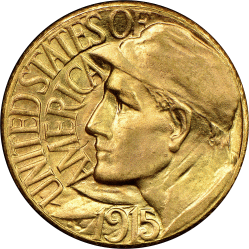 Charles Keck designed this commemorative gold dollar issued to celebrate the opening of the Panama Canal at the Panama-Pacific International Exposition held in San Francisco. The obverse features the head of a typical laborer who helped build the canal and the reverse shows two dolphins to signify the linking of the Atlantic and Pacific Oceans.
Charles Keck designed this commemorative gold dollar issued to celebrate the opening of the Panama Canal at the Panama-Pacific International Exposition held in San Francisco. The obverse features the head of a typical laborer who helped build the canal and the reverse shows two dolphins to signify the linking of the Atlantic and Pacific Oceans.
A total of 25,000 pieces were authorized and struck but only 15,000 were actually sold. The remaining specimens were later melted. The coins were issued in small envelopes and these are sometimes seen but are quite rare.
The original price for the Panama-Pacific gold dollar was $2 each or six for $10.
All of the coins seen by the author have been frosty in appearance. Any friction seen is usually found on the cap of the laborer. Counterfeits are very common, and only certified coins should be considered for purchase.
1915-S Panama-Pacific International Exposition Quarter Eagle
- Net Mintage: 6,749
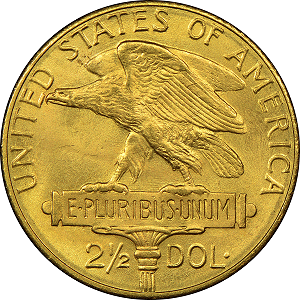 Charles E. Barber, George T. Morgan and William Malburn collaborated in the design of this commemorative quarter eagle. The obverse features Columbia riding a hippocampus illustrating the linking of the Atlantic and Pacific Oceans. She is holding a caduceus, which symbolizes the successful victory by Colonel William Gorgas and the Army Medical Corps yellow fever and malaria outbreaks which had slowed the building of the Panama Canal in earlier years.
Charles E. Barber, George T. Morgan and William Malburn collaborated in the design of this commemorative quarter eagle. The obverse features Columbia riding a hippocampus illustrating the linking of the Atlantic and Pacific Oceans. She is holding a caduceus, which symbolizes the successful victory by Colonel William Gorgas and the Army Medical Corps yellow fever and malaria outbreaks which had slowed the building of the Panama Canal in earlier years.
A total of 10,000 pieces were authorized. The unsold pieces (3,251) were melted. Like the gold dollar the quarter eagle was issued in a small envelope with details of the coin and ordering information printed on the front. Only two quarter eagle commemorative issues were produced, the Panama-Pacific being much rarer than the Sesquicentennial issue of 1926.
Counterfeits are often encountered, and certification is highly recommended.
1915-S Panama-Pacific International Exposition Octagonal Fifty-Dollar Gold Piece
- Net Mintage: 645
Robert Aitken designed this, the largest and heaviest of all regularly-issued United States commemorative coins. The obverse features the helmeted head of Minerva. The helmet is pushed to the back of Minerva’s head signifying peaceful intentions. The reverse shows an owl, symbolizing wisdom.
A total of 1,500 of each version (octagonal and round) of this $50 commemorative were authorized. The original selling price was $100. At the conclusion of the Exposition, 855 octagonal examples remained unsold and were subsequently melted. Original packaging includes boxes in various configurations and copper frames for single and double sets. The Panama-Pacific $50 gold coins are one of the most stunning issues ever produced by the United States Government.
Counterfeits of the issue are virtually unknown, but certification is still recommended due to the extremely high market value in various grades.
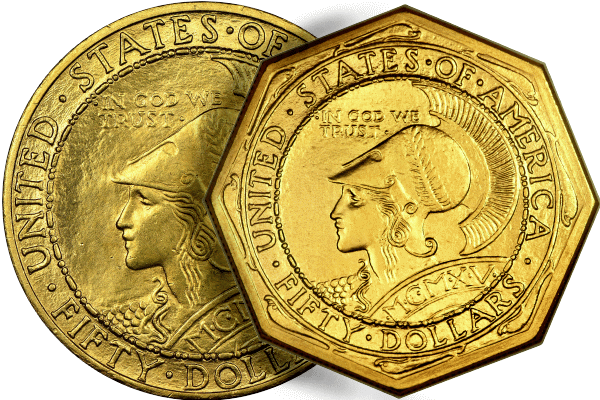
1915-S Panama-Pacific International Exposition Round Fifty-Dollar Gold Piece
- Net Mintage: 483
The round version of the Panama-Pacific $50 gold commemorative features a similar design as its “octagonal” counterpart. The diameter of this coin was a whopping 60 millimeters and was struck on a 14-ton press shipped from the Philadelphia Mint to the Exposition in San Francisco. Due to the size of these coins, tremendous pressure was required to strike them. As a result, the die life was rather short. In fact, the first die broke after striking only 62 coins.
Of the 1,500 round examples ultimately struck, only 483 were actually sold, leaving 1,017 pieces to be melted. Original packaging includes boxes in various configurations and copper frames for single and double sets. The round is slightly rarer than the octagonal issue and most of the coins seen are Brilliant Uncirculated. Circulated examples are occasionally encountered. The population data for the Panama-Pacific $50 issues are grossly inaccurate due to resubmissions. The number of coins on the reports far exceed the net mintage.
1916 McKinley Memorial Gold Dollar
- Net Mintage: 15,000 Estimated
Charles E. Barber and George T. Morgan teamed up to design this commemorative gold dollar which was issued to raise funds for the construction of the McKinley Memorial in the former president’s birthplace of Niles, Ohio. The obverse (Barber’s design) features the bust of President William McKinley and the reverse shows the actual memorial (Morgan’s design).
A total of 100,000 pieces were authorized to be struck, but the actual number of coins sold to the public fell far short of this number. The rest were ultimately melted.
The original issue price was $3 but sale prices were heavily discounted in later years.
Most of the coins seen are frosty, but Prooflike pieces are frequently encountered. Counterfeits for the 1916 McKinley gold dollar are very common, and certified examples are highly recommended.
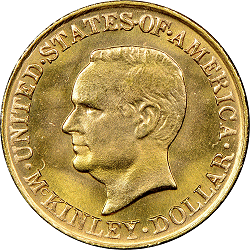 1917 McKinley Memorial Gold Dollar
1917 McKinley Memorial Gold Dollar
- Net Mintage: 5,000 Estimated
Identical in design to the 1916 examples, fewer 1917-dated pieces were actually sold. Originally selling for $3 each through the McKinley Birthplace Association, few actually were sold. Well-known coin dealer of the day, B. Max Mehl, subsequently acquired 10,000 pieces which he offered to collectors for $2.50 each. It is not clear as to the specific breakdown of dates Mehl acquired, leaving the actual net mintage for each date somewhat speculative. It is generally believed the 1917-dated pieces are somewhat scarcer as only 10,000 were originally struck.
The surfaces of most coins seen are frosty, but many are found with a Prooflike or deeply Prooflike appearance. Counterfeits are often seen and only certified pieces should be considered.
1922 Grant Memorial Gold Dollar (With Star in Field)
- Net Mintage: 5,000
The first versions of the Grant commemorative coins, both gold dollars and silver half dollars, were struck with an incuse star on the obverse field above the “N” in GRANT. The gold dollar “with star” versions sold for $3.50 each.
Sculptor James Earle Fraser, member of the Federal Commission of Fine Arts (CFA), was responsible for choosing the design for this coin celebrating the centennial of Ulysses S. Grant’s birth. He selected his wife, Laura Fraser, the designer of the 1921 Alabama Commemorative Half Dollar, to design this coin. The obverse features the bust of President Grant and the reverse shows his birth home in Point Pleasant, Ohio.
Unlike many of the other commemorative gold issues, the Grant gold dollars are usually found in very choice condition. Circulated examples are rarely seen. Counterfeits were made of both varieties, and caution should be made when purchasing an uncertified example.
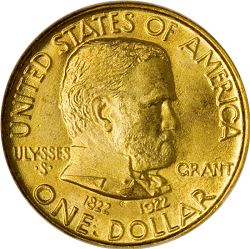 1922 Grant Memorial Gold Dollar (No Star in Field)
1922 Grant Memorial Gold Dollar (No Star in Field)
- Net Mintage: 5,000
Struck after the Grant “with star” version, these coins are otherwise identical to the earlier issues. The “star less” versions were sold for $3 each by the Grant Centenary Commission. An identical mintage of 5,000 coins was struck with none being melted. The Grant commemoratives were issued to raise funds to help finance the construction of Grant Memorial buildings near Cincinnati and to build a five-mile highway from New Richmond to Point Pleasant, Ohio – two villages where Grant lived prior to the Civil War.
The “no star” variety is slightly scarcer than the “with star” variety. Most of the survivors are very choice, and circulated pieces are rarely encountered.
1926 Sesquicentennial of American Independence Quarter Eagle
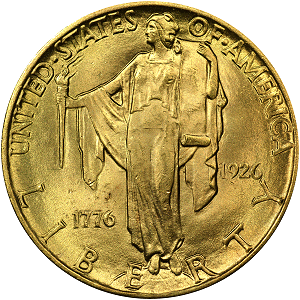 Net Mintage: 46,019
Net Mintage: 46,019
The 150th Anniversary of the Signing of the Declaration of Independence was commemorated with the issuance of a commemorative half dollar and quarter eagle. Both coins were designed by John R. Sinnock, who is perhaps best known for his Roosevelt dime and Franklin half dollar designs. The obverse features Liberty holding a scrolled Declaration of Independence. The reverse shows Independence Hall in Philadelphia.
These coins were sold by the Sesquicentennial Commission in 1926 to defray costs related to the celebration’s expenses. A total of 200,000 pieces were minted but nearly 155,000 specimens remained unsold and were melted. As would be expected for the much higher mintage, more examples of the Sesquicentennial have been certified than any other issue. Most of the coins however are MS 62 to MS 64. Gem and Superb examples are quite rare.
PROOF STRIKES
1903 Louisiana Purchase Exposition Gold Dollar–Jefferson
- Mintage: 100
Reportedly the first 100 coins struck of the Jefferson gold dollar were produced in the Brilliant Proof format. True Proof examples have deeply mirrored fields and are sharply struck. Many also exhibit frosted devices giving the coins a cameo appearance.
Although many of the coins seen today have been certified and lack original packaging, they were originally housed in a cardboard holder certifying the coins as having been one of the first one hundred impressions from the dies. The original holders are quite interesting, with the coin covered by a small piece of wax paper and a piece of string sealed by dark red wax. The coins are difficult to see behind the wax paper and the author has seen holders with a circulation strike example substituted for the Proof piece.
Caution should be used when purchasing an example of this extreme rarity. An NGC PR 66 example sold at public auction in late 2012 for $19,975.
1903 Louisiana Purchase Exposition Gold Dollar—McKinley
- Mintage: 100
As with the Jefferson issue the first 100 coins struck were produced in the Brilliant Proof format. Of the 100 coins struck less than two dozen probably survive today. The McKinley issue is also found housed in the original framed holder with a small piece of wax covering the coin and a piece of string sealed with dark red wax.
Prooflike circulation strike examples are quite common for the issue and true proofs can be distinguished by deeply mirrored surfaces and cameo devices. Certification is highly recommended. In 2013 an NGC PR 66 example sold at auction for $27,025.
1904 Lewis and Clark Exposition Gold Dollar
- Mintage: Unknown
The existence of this issue had not been confirmed until recent years. Walter Breen lists an example as residing in the Smithsonian and another in the American Numismatic Society (ANS) collection. The Smithsonian example is not a true Proof, but a prooflike circulation strike example. Knowledgeable experts have stated they believe that the 1904 Lewis and Clark gold dollar exits in Proof, and NGC has certified two coins, but this could be the same coin. The issue is very rare and an NGC PR 64 sold for $30,550 in 2015.
1915-S Panama-Pacific International Exposition Quarter Eagle
- Mintage: Unknown
While doing research for the Encyclopedia of United States Gold Coins, the author had the pleasure and the great privilege of carefully studying the United States gold coins in the Smithsonian collection. One of the most exciting discoveries was finding an example of the 1915-S Panama-Pacific International Exposition Quarter Eagle in Roman Finish Proof. The coin is extremely well struck and matches the surface of the 1909 and 1910 Roman finish gold coins. For now the Smithsonian example is unique, and ranks as one of the most exciting discoveries of that project.
1916 McKinley Memorial Gold Dollar
- Mintage: Unknown
This is an issue that I had not personally examined until recent years. NGC and PCGS have certified three or four coins. This may only represent one or two coins because of resubmissions. Breen mentions a coin in the Smithsonian collection, but that example is not a true proof by today’s standards. An NGC PR 63 sold for $37,600 in 2015.
1926 Sesquicentennial of American Independence Quarter Eagle
- Mintage: Unknown
A single example of this issue is known in the proof format. The coin is unique and displays a matte surface similar to the Proof gold coins of 1908-1915. NGC has certified the coins as PR 65. The piece was reportedly from the estate of the designer, John R. Sinnock, who is best known for his Roosevelt dime and Franklin half dollar designs. The piece was in the possession of coin dealer David Bullowa in the 1950s. Proof gold commemoratives are all very rare and desirable. The 1903 Jefferson and McKinley issues are the only ones that can be found with any regularity. The appearance of any other issue in proof is a numismatic event, and decades may elapse between offerings.
Collecting Tips
Buy the best coins you can afford. Commemorative gold coins have an unusual price compression in the higher grades. An MS 66 coin can be purchased for prices that are not much above that for MS 65. Collectors should take advantage of this pricing aberration. Many commemorative gold coins are seen with minor to major copper spotting. These should be avoided, as this will greatly affect resale when it’s time to dispose of your collection. Shop for best prices and don’t buy the first coin you see. It is a buyer’s market for this series, and there are incredible bargains to be had if you spend the time looking. Check current population data and pricing information on the NGC website
This is great time to collect one of the most interesting and attractive United States coins series. Do your homework and be a fussy buyer. Your time and efforts will be well rewarded.
Questions about the rare coin market? Send them to [email protected].
* * *
About Jeff Garrett
 Jeff Garrett, founder of Mid-American Rare Coin Galleries, is considered one of the nation’s top experts in U.S. coinage — and knowledge lies at the foundation of Jeff’s numismatic career. With more than 35 years of experience, he is one of the top experts in numismatics. The “experts’ expert,” Jeff has personally bought and sold nearly every U.S. coin ever issued. Not a day goes by that someone doesn’t call on Jeff Garrett for numismatic advice. This includes many of the nation’s largest coin dealers, publishers, museums and institutions.
Jeff Garrett, founder of Mid-American Rare Coin Galleries, is considered one of the nation’s top experts in U.S. coinage — and knowledge lies at the foundation of Jeff’s numismatic career. With more than 35 years of experience, he is one of the top experts in numismatics. The “experts’ expert,” Jeff has personally bought and sold nearly every U.S. coin ever issued. Not a day goes by that someone doesn’t call on Jeff Garrett for numismatic advice. This includes many of the nation’s largest coin dealers, publishers, museums and institutions.
In addition to owning and operating Mid-American Rare Coin Galleries, Jeff Garrett is a major shareholder in Sarasota Rare Coin Galleries. His combined annual sales in rare coins and precious metals — between Mid-American in Kentucky and Sarasota Rare Coin Galleries in Florida — total more than $25 million.
Jeff Garrett has authored many of today’s most popular numismatic books, including Encyclopedia of U.S. Gold Coins 1795–1933: Circulating, Proof, Commemorative, and Pattern Issues; 100 Greatest U.S. Coins; and United States Coinage: A Study By Type. He is also the price editor for The Official Redbook: A Guide Book of United States Coins.
Jeff was also one of the original coin graders for the Professional Coin Grading Service (PCGS). He is today considered one of the country’s best coin graders and was the winner of the 2005 PCGS World Series of Grading. Today, he serves as a consultant to Numismatic Guaranty Corporation (NGC), the world’s largest coin grading company.
Jeff plays an important role at the Smithsonian Institution’s National Numismatic Department and serves as consultant to the museum on funding, exhibits, conservation and research. Thanks to the efforts of Jeff and many others, rare U.S. coins are once again on exhibit at the Smithsonian Institution’s Museum of American History. We urge everyone who visits Washington, D.C., to view this fabulous display.
Jeff has been a member of the prestigious Professional Numismatic Guild (PNG) since 1982 and has recently served as president of the organization. In 2009 and 2011, Jeff ran successfully for a seat on the Board of Governors for the American Numismatic Association (ANA), the leading numismatic club in the world. and he is currently the ANA President.




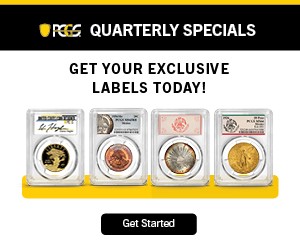
Informative article, thanks Jeff.